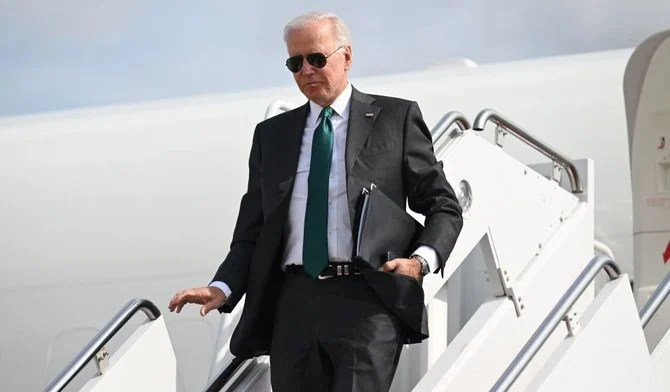
- ARAB NEWS
- 05 Jul 2025

US officials and analysts are carefully watching the protest movement in Iran. Returning to a nuclear deal with Tehran has been a top foreign policy priority for the Biden administration, but the recent anti-government protests might be changing the White House’s calculus.
The current protest movement began in mid-September following the death of a young woman, Mahsa Amini, while in morality police custody. Small protests quickly evolved into large, widespread demonstrations that present a serious problem for the government.
President Joe Biden and his foreign policy officials have tried to demonstrate support for the protesters while keeping their options open. President Barack Obama faced criticism in 2009 for not doing more to support the Green Movement protests in Iran and Biden is taking a somewhat different approach, quickly expressing support for the protesters and condemning the government’s violent response. At a speech before the UN General Assembly in September, Biden said that the US stands “with the brave citizens and the brave women of Iran who right now are demonstrating to secure their basic rights.” Since then, Biden and senior foreign policy officials have expressed support for the protesters.
The administration has also taken practical steps. In September, the US imposed sanctions on Iran’s morality police and seven leaders of Iranian security organizations. This month, it added sanctions on seven Iranian officials deemed responsible for restricting internet access. Washington also took steps to ease the provision of digital services to Iranians, particularly loosening some sanctions that might have blocked technology companies from working in Iran and encouraging those companies to “facilitate greater access for the Iranian people to secure online platforms and services.”
Meanwhile, Iran experts in Washington are debating what the protests could mean for the country, including whether the protests could turn into a full revolution. There is a general consensus that this protest movement is a serious development and is unlikely to be completely quashed by the government. A number of experts have said that the revolution is starting, but others are more cautious. Even if a revolution occurs, there are many potential outcomes, which may or may not align with US interests.
As experts and officials debate the future of Iranian politics, there is a related discussion about US policy toward the Iran nuclear deal, known as the Joint Comprehensive Plan of Action. There are three competing positions. First, opponents of the JCPOA say that the protests in Iran provide additional arguments against returning to the agreement. Second, some JCPOA advocates argue that returning to the agreement is more important than ever. Third, other JCPOA supporters suggest a wait-and-see approach; while they still support a nuclear deal with Iran in principle, they are not sure that the current moment is a good time to pursue it.
It is not yet fully clear what approach the Biden administration will take, but the White House seems to be following the wait-and-see approach. At the UN, Biden repeated his commitment to ensuring that Iran does not acquire a nuclear weapon, while adding that “I continue to believe that diplomacy is the best way to achieve this outcome.”
Before the current protests began, the JCPOA was stalled. After hopes for an agreement rose over the summer, Iran made additional demands, leaving the negotiations in limbo and unlikely to move much before the US midterm elections in November.
Now, the protest movement in Iran is shifting Washington’s calculus, as Biden and his officials consider whether and how to approach the stalled nuclear negotiations. The protests are now layered on top of the previous challenges. No one wants to invest too much in a government that has an uncertain future. Iran has used uncertainty over who will succeed Biden as president as a bargaining chip in talks. Washington might now demonstrate reluctance to make a deal with an Iranian government in crisis.
The US government is not pursuing regime change in Iran. At the same time, it does not want to do anything to prop up the current regime. The Biden administration saw the JCPOA as a valuable deal that limited and monitored Iran’s nuclear program and there were hopes that sanctions relief might help reintegrate Iran into the global economy and moderate its government. Now, the White House is reluctant to lift sanctions if it might benefit a government that is violently responding to protests, especially when Iranians are calling for an end to that government.
The White House is reluctant to lift sanctions if it might benefit a government that is violently responding to protests.
Kerry Boyd Anderson
Biden must also consider the domestic political implications of signing a deal with Iran in the wake of these protests. Biden promised to make human rights a top priority in foreign policy but has taken a more pragmatic approach in office. However, he would not welcome the image of signing an agreement with a government at the same time that it is actively using significant violence against people calling for basic rights. At the very least, little progress in negotiations is likely before the US elections on Nov. 8.
US presidents and their senior officials always come into office with ambitious foreign policy plans and events outside of their control always disrupt those plans. Biden’s pursuit of a return to the JCPOA is a good example. Previously, Biden’s team had to manage obstacles created by the Iranian government; now, the Iranian people have created unexpected complications. Biden may have been willing to negotiate hard with the Iranian regime, but he is unlikely to take steps that might appear to undermine the protest movement.